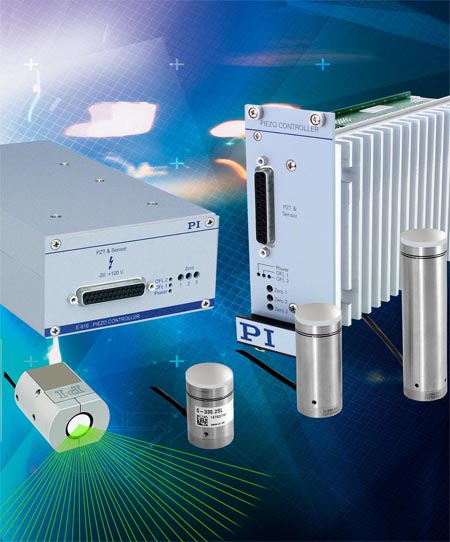Home > Press > Optical Path Control, Beam Steering & Image Stabilization with Lower Cost Piezo Controll
 |
| E616 controller HeatSink and benchtop model with S330 s334 tip-tilt Mirror |
Abstract:
Auburn, MA, Piezo system specialist PI has extended its E-616 multi-channel controller line for piezo based steering & stabilization mirror platforms. Four open and closed-loop models are now available in bench-top and OEM module versions. The closed-loop units contain two servo controllers, sensor circuit channels and 3 power amplifiers.
Optical Path Control, Beam Steering & Image Stabilization with Lower Cost Piezo Controll
Auburn, MA | Posted on September 2nd, 2009Features and Advantages of the E-616 Multi-Axis Controller:
* Three Integrated Amplifiers Provide up to 10 W Peak Power
* Closed-Loop and Open-Loop Versions
* Bench-Top and OEM Modules
* Internal Coordinate Transformation Simplifies Control of Parallel Kinematics Designs (Tripod & Differential Drive)
Piezo Steering Mirrors: Why?
Piezo steering mirrors are faster than galvo mirror scanners and provide improved resolution and stability due to their high-stiffness, solid-state piezo drives. They are used to steer or stabilize beams or enhance image resolution. Applications range from optical commumication, astronomy and super-resolution microscopy to nano-lithography.
Tripod and Quadra-Pod Differential Drive Versions
The controllers can drive parallel-kinematics (highest performance mechanics, where all piezo actuators are connected to the same moving platform) steering mirror designs. With the tripod design (for S-325 Z/Tip/Tilt mirrors), the platform is driven by three piezo actuators at 120° spacing. The quadra-pod differential drive design (as used in the S-330, or S-334 mirror models) runs two orthogonal axes with a fixed pivot point based on two pairs of actuators operating in push / pull-mode. The differential evaluation of two sensors per axis improves linearity, stability and resolution.
Internal Coordinate Transformation Simplifies Control
Parallel-kinematics requires the transformation of the commanded tilt angles into the corresponding linear motion of the individual actuators. In the E-616, this is taken care of by an integrated circuit, eliminating the need of additional external hardware or software. Additionally, with the E-616.S0 tripod version, all actuators can be commanded by an offset-voltage simultaneously. As a result, a vertical movement, for example for optical path length tuning, is obtained.
Simple Setup and Operation
To facilitate integration, setup and operation the E-616 features both front and rear panel connections: The 25 pin sub-D piezo & sensor connector is located on the front, along with offset trim pots and LEDs for Power and Overflow. A 32-pin rear connector allows commanding and reading the sensor and amplifier monitor outputs.
####
About Physik Instrumente
When PI introduced piezoelectric nanopositioning technology more than 30 years ago, typical customers were research labs and universities working on laser cavity tuning, Fabry-Perot interferometers and filters. Few foresaw that whole industrial sectors like semiconductor manufacturing or biotechnology would become dependent on progress in nanopositioning. Today, not even the precision machining industry can do without nanometer-level positioning systems.
For more information, please click here
Contacts:
Steve Vondan
Phone: 508-832-0506
Fax: 508-832-3456
Copyright © Physik Instrumente
If you have a comment, please Contact us.Issuers of news releases, not 7th Wave, Inc. or Nanotechnology Now, are solely responsible for the accuracy of the content.
| Related News Press |
News and information
![]() Simulating magnetization in a Heisenberg quantum spin chain April 5th, 2024
Simulating magnetization in a Heisenberg quantum spin chain April 5th, 2024
![]() NRL charters Navy’s quantum inertial navigation path to reduce drift April 5th, 2024
NRL charters Navy’s quantum inertial navigation path to reduce drift April 5th, 2024
![]() Discovery points path to flash-like memory for storing qubits: Rice find could hasten development of nonvolatile quantum memory April 5th, 2024
Discovery points path to flash-like memory for storing qubits: Rice find could hasten development of nonvolatile quantum memory April 5th, 2024
Nanoelectronics
![]() Interdisciplinary: Rice team tackles the future of semiconductors Multiferroics could be the key to ultralow-energy computing October 6th, 2023
Interdisciplinary: Rice team tackles the future of semiconductors Multiferroics could be the key to ultralow-energy computing October 6th, 2023
![]() Key element for a scalable quantum computer: Physicists from Forschungszentrum Jülich and RWTH Aachen University demonstrate electron transport on a quantum chip September 23rd, 2022
Key element for a scalable quantum computer: Physicists from Forschungszentrum Jülich and RWTH Aachen University demonstrate electron transport on a quantum chip September 23rd, 2022
![]() Reduced power consumption in semiconductor devices September 23rd, 2022
Reduced power consumption in semiconductor devices September 23rd, 2022
![]() Atomic level deposition to extend Moore’s law and beyond July 15th, 2022
Atomic level deposition to extend Moore’s law and beyond July 15th, 2022
Announcements
![]() NRL charters Navy’s quantum inertial navigation path to reduce drift April 5th, 2024
NRL charters Navy’s quantum inertial navigation path to reduce drift April 5th, 2024
![]() Discovery points path to flash-like memory for storing qubits: Rice find could hasten development of nonvolatile quantum memory April 5th, 2024
Discovery points path to flash-like memory for storing qubits: Rice find could hasten development of nonvolatile quantum memory April 5th, 2024
Tools
![]() Ferroelectrically modulate the Fermi level of graphene oxide to enhance SERS response November 3rd, 2023
Ferroelectrically modulate the Fermi level of graphene oxide to enhance SERS response November 3rd, 2023
![]() The USTC realizes In situ electron paramagnetic resonance spectroscopy using single nanodiamond sensors November 3rd, 2023
The USTC realizes In situ electron paramagnetic resonance spectroscopy using single nanodiamond sensors November 3rd, 2023
|
|
||
|
|
||
| The latest news from around the world, FREE | ||
|
|
||
|
|
||
| Premium Products | ||
|
|
||
|
Only the news you want to read!
Learn More |
||
|
|
||
|
Full-service, expert consulting
Learn More |
||
|
|
||








